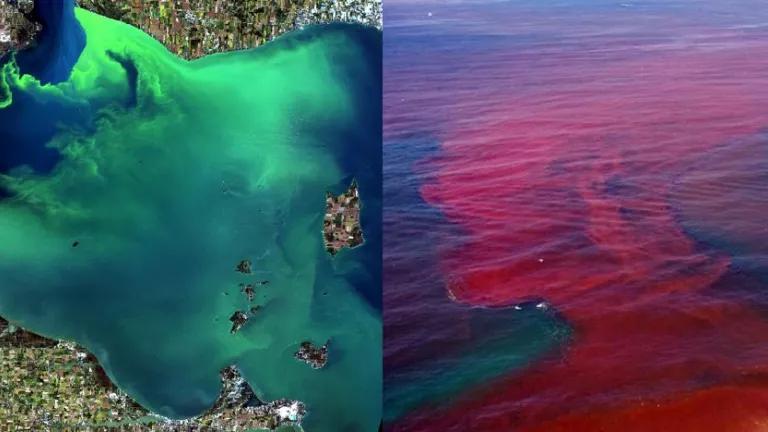Don’t Stop to Smell These (Harmful Algal) Blooms
If you’ve heard some sad stories this summer about pet dogs perishing after swimming in scummy ponds, take heed. You’re a mammal, too.

Photo credit (left to right): Landsat-8 (NASA/USGS satellite); NOAA
Those deaths were caused by Harmful Algal Blooms (HABs), which plague every coastal and Great Lakes state in the U.S. While these outbreaks of algae sometimes dazzle us in their shades of blue, green, or even red, consider this display to be nature’s warning sign and STAY AWAY.
HABs produce a range of toxins that can kill fish, marine mammals, birds, and pets. And, people are no exception. Swimming in or drinking contaminated water, eating contaminated seafood, or inhaling airborne algal toxins can cause serious illness and even death.
A newly-released NRDC assessment of freshwater HAB protection programs shows that we need to get more serious about documenting these blooms, so that people and their pets can plan for safe outdoor recreation, away from risky waterways.
Climate change isn’t helping matters either. It fuels warmer water temperatures that encourage the rapid growth of a “bloom.” The range of some of the 100 or so known species that can produce HABs is creeping farther northward into new areas. Climate change also fuels more frequent extreme rains, which can wash nutrients like nitrogen and phosphorus off farmers’ fields, factory farms, and sewage treatment outfalls into freshwater lakes, ponds, and estuaries. The EPA warns that climate change is causing warmer water temperatures, augmented levels of CO2 and salinity in waters, and increased nutrient runoff. Essentially, it’s the perfect storm for boundless HAB growth.
Cyanobacteria usually proliferate in freshwater to form HABs, while ocean HABs typically result from algae. HAB species can produce toxins that can cause liver damage, gastrointestinal upset, headaches, skin irritation, joint and muscle pain, and/or short-term memory loss in people. These exposures can lead to a number of health issues, including paralysis from paralytic shellfish poisoning. For someone with a pre-existing condition such as asthma, inhaling airborne toxins from a marine HAB can impair breathing for days. The concentration of these toxins in waterways soars during a bloom, closing fisheries and shellfish harvesting for extended periods. But unless people know about an HAB, swimmers can swallow contaminated water, breathe aerosolized toxins as they Jet Ski or speed boat, or unwittingly consume contaminated seafood.
Here are some of the main HAB-related health concerns:

Source: Tides of Trouble (NRDC, 2010)
Once you’re in the proximity of an HAB, human health risks soar. Boiling contaminated water or cooking contaminated seafood does not remove HAB toxins. Children, older adults, and people with pre-existing respiratory ailments are among those most susceptible to HAB toxins and should take extra care to avoid contact with contamination. Individual HAB events can cost coastal communities tens of millions of dollars.
The serious threat posed by HABs calls for a serious response. In addition to keeping our beloved pooches away from brightly-colored ponds and waterways, we need our decisionmakers to step up efforts to cut both the nutrient pollution feeding blooms and the carbon pollution fueling climate change. At the same time, public health practitioners and other officials need to prepare for the possibility of HABs getting worse and showing up in new places as the world warms. Adaptive measures should include centrally tracking HAB occurrences, better publicizing HAB threats to the most vulnerable communities, weather-proofing storm- and drinking water infrastructure, and ensuring that healthcare providers know how to identify and treat illnesses associated with HABs.
Let’s get real about protecting the freshwater places we rely on in summer. Our health depends on it—along with the health of our fishes and our Fidos.


